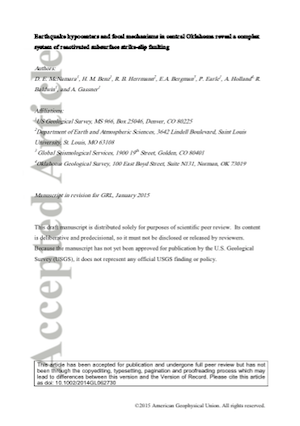
Click here to read a .pdf of the study, "Earthquake hypocenters and focal mechanisms in central Oklahoma reveal a complex system of reactivated subsurface strike-slip faulting."
Geophysical Research Letters


Click here to read a .pdf of the study, "Earthquake hypocenters and focal mechanisms in central Oklahoma reveal a complex system of reactivated subsurface strike-slip faulting."
Geophysical Research Letters

Geophysical Research Letters
Click here to read a .pdf of the study, "Earthquake hypocenters and focal mechanisms in central Oklahoma reveal a complex system of reactivated subsurface strike-slip faulting."
The faults responsible for thousands of earthquakes in Oklahoma are capable of producing larger earthquakes, according to a new study.
These “reactivated” faults were formed roughly 300 million years ago and are well known for creating underground structures that “trap” oil and natural gas, the U.S. Geological Survey wrote in a statement about the new research.
A primary reason for reactivation is the northeast or northwest orientation of the faults relative to the east to west direction of regional tectonic stress in earth’s upper crust, which increases the probability of a future, larger earthquake.
Typically, these faults are shallow — about 2.5 to 3.5 miles deep — and vertically oriented. Between 2009 and 2014, more than 3,600 earthquakes were recorded near such faults in Oklahoma, the USGS writes.
Several of these earthquakes caused damage and many were felt, with over 153,000 individual felt reports for 474 separate earthquakes entered at the USGS.
The paper points out several “earthquake clusters” that are of “particular concern” for producing larger earthquakes, including areas near the communities of Langston, Cushing, Medford and Stillwater.
The peer-reviewed paper, published in Geophysical Research Letters, was written by USGS research geophysicist Dan McNamara. Oklahoma’s state seismologist, Austin Holland of the Oklahoma Geological Survey, was one of the paper’s co-authors.
Since 2009, the number of 3.0-magnitude earthquakes in Oklahoma has surged more than 300 percent. Other peer-reviewed papers have linked some of the shaking to disposal wells the oil and gas industry pumps full of wastewater and toxic drilling fluid — a process known as “induced seismicity.”
McNamara’s paper focuses on the fault formations, not the cause of the quakes, but a better understanding of both concepts is key to predicting earthquake hazards and updating maps and models — which currently don’t include risks posed by manmade earthquakes — that are used by public safety and infrastructure officials and the construction and insurance industries, the USGS writes.
Augmenting these maps with information about the type, length and location, of the reactivated faults will help officials provide guidance to the oil and gas industry and aid in adapting building codes to ensure that structures can withstand more damaging earthquakes, he added.